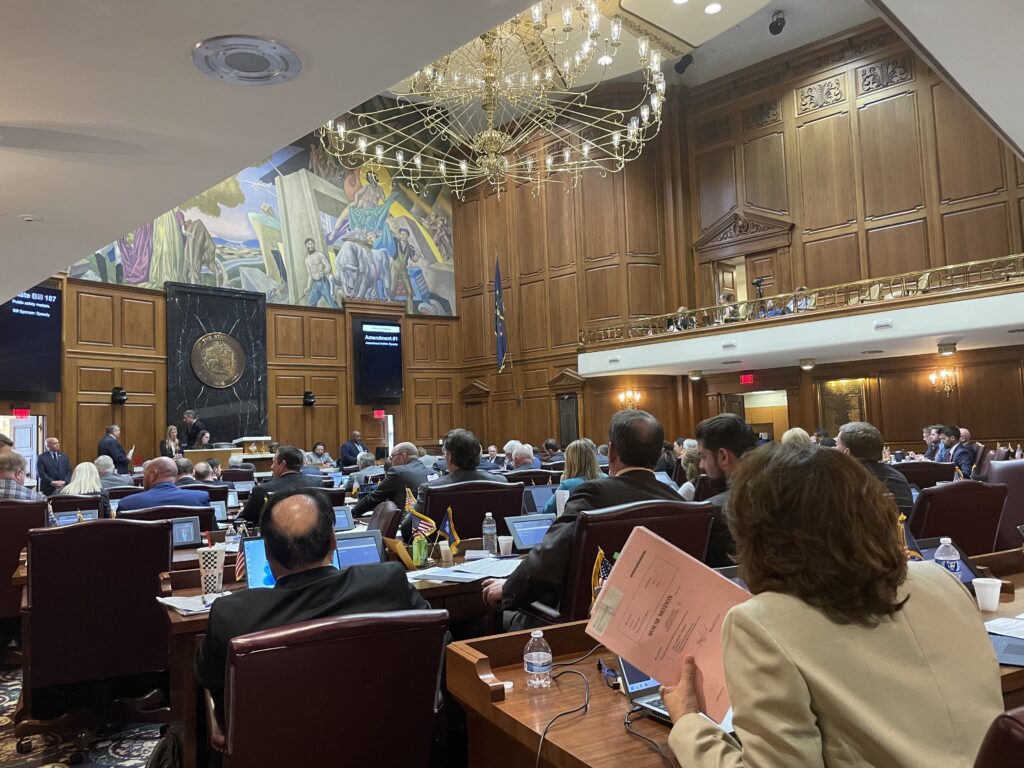
The Indiana legislature reconvenes Jan. 8. (Leslie Bonilla Muñiz/Indiana Capital Chronicle)
When the General Assembly returns January 8, it is clear nothing about the session will be bold, aggressive or transformational.
Republican leaders have cautioned so. They’re starting a few days later than usual and likely leaving early to focus on elections for 125 lawmakers.
That means there likely won’t be any meaningful action to help Hoosiers coping with high child care costs; no additional money dedicated to drooping reading scores; no solution for a budding water war; no movement on legalizing marijuana.
Instead, they will “fine-tune” some items and address reading and truancy in some way.
Call it a status-quo session. A placeholder. Do no harm.
“We will have fewer agenda bills, a signal that leadership is of a ‘less is more opinion’ right now. … Short sessions are supposed to be for emergency items only,” GOP House Speaker Todd Huston said at a legislative preview this month. “We’ve kind of expanded the definition of emergency through the years but we’ll try to get back to the more limited agenda.”
So why does Indiana even have short sessions in even-numbered years?
Going back in time
That goes back to a 1970 constitutional amendment allowing the General Assembly to set the length and frequency of its own sessions. The year after, lawmakers passed a bill to return in annual sessions instead of every other year.
To avoid becoming a full-time legislature, there are limits to the sessions. The long budget session in odd-numbered years must end by April 30 and the short session must end by March 14.
According to the “Centennial History of the General Assembly,” the first short session in 1972 was described by Edward Ziegner, dean of the Statehouse reporters, as “unloved, unmourned and cursed even by some of its own members.” He found a short session convening in a year with a governor’s contest and other elections sidetracked substantive issues.
Then, in 1974, Senate President Pro Tem Phillip Gutman urged a re-evaluation of short sessions. “I feel we must find some technique to define what we want to do in an off session.”
After a dismal 1976 session with a politically divided General Assembly, then-Rep. Kermit Burrous — who authored the bill moving to annual sessions just a few years prior — admitted to having second thoughts about the change.
By 1978, the legislature remained split but moved major legislation involving state construction projects, highways, streets and roads, increased school funding and removal of a sales tax on gasoline, the centennial history shows.
Recent decades
Ultimately, a rule change in 1980 indicated short sessions were for emergency legislation only, or as the Indianapolis Star explained “business that can’t wait until the next year’s long session.” But subjects considered that year included posting the Ten Commandments in every public school classroom, according to the history book.
Since then, internal House and Senate rules have placed limits on the number of bills that can be filed to try to control the short session.
And over the years, some significant legislation has passed during the short session. Former Gov. Mitch Daniels especially didn’t believe in wasting any sessions. In 2006 he pushed through a bill allowing him to lease the Indiana Toll Road for billions in road-funding dollars. Then in 2012, Daniels used another short session to pass a right-to-work-law limiting unions.
This shows that the Indiana General Assembly can do big things that impact Indiana in the short session — if they want to. Or they can head home and run for re-election.
By Niki Kelly December 1, 2023
Niki has covered the Indiana Statehouse since 1999 – including five governors. She has been honored by the Society of Professional Journalists and Hoosier State Press Association for stories on the Religious Freedom Restoration Act, criminal justice issues and more. She also is a regular on Indiana Week in Review, a weekly public television rundown of news. She shifts her career to helm a staff of three and ensure Hoosiers know what’s really happening on the state level.
